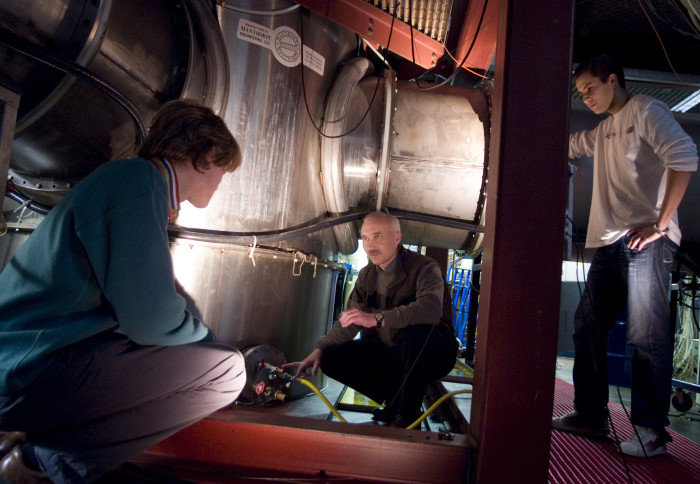
Members of the Plasma Physics Group: Brian Applebe (on the left), Prof. Sergey Lebedev (middle), and Nicolas-Pierre Niasse (right).

Plasma physicists from Imperial College London contributed to the fusion breakthrough announced at the National Ignition Facility in the US.
The international effort to develop inertial confinement fusion as a potential energy source has been a multi-decade endeavour, involving plasma physicists from Imperial College London.
On 13 December 2022, the US announced that experiments at the National Ignition Facility (NIF) (part of the Lawrence Livermore National Laboratory) achieved a gain of greater than one for the first time. This meant that the fusion energy that came out of the reaction was greater than the energy of the laser beams driving it. This is an achievement that has triggered a huge amount of excitement and interest from around the world.
“This wonderful result shows that inertial fusion works at the megajoule scale which gives huge impetus to its development for a power source and as a tool for fundamental science,” says Professor Steven Rose, Chair in Plasma Physics.
Researchers at Imperial College London, and in particular the Plasma Physics Group, have been involved with and influencing the US programmes in inertial fusion for decades since its inception. Sir George Thomson, a Nobel Laureate who filed the first patent for a fusion reactor in 1946, was part of the group.
The US and the UK have few academic institutions conducting research into fusion (either magnetic or inertial), and the Plasma Physics Group at the university is arguably the largest. It has, over the years, moved away from magnetic fusion and towards inertial fusion.
Staff and students from the university have occupied senior positions in inertial fusion experimental laboratories around the world, but particularly at NIF where the breakthrough occurred. Former Imperial College London staff members John Edwards, Nino Landen, Richard Town, Dick Lee and Joe Kilkenny are currently working at NIF, alongside many PhD students.
The Plasma Physics Group has ‘exported’ many other PhD students to other US National Laboratories, particularly Sandia National Laboratory and the Laboratory for Laser Energetics in Rochester. Both these labs work on inertial confinement fusion with NIF.
Another important connection has been through a company, Kentech Instruments Ltd., which was was founded by Plasma Physics Group members Jonathan Hares (staff) and Tony Dymoke-Bradshaw (PhD student) in 1983. With the cooperation of the university at its founding, Kentech Instruments has since gone on to develop many of the ultra-fast diagnostics that are used at NIF.
The Plasma Physics Group continues to work with the NIF, in particular Jerry Chittenden (staff), Brian Applebe (Postdoc), Aidan Crilly (Postdoc) and Steven Rose (staff). The group continues to be active in the realms of fundamental plasma physics, which underpins research in a wide spectrum of fields such as astrophysics, space physics and controlled thermonuclear fusion. The Plasma Physics Group also has a strong presence in applied technologies, such as next-generation spacecraft propulsion and developing AI systems for research.
You can learn more about post-graduate and research opportunities on the Imperial College London website.
Article text (excluding photos or graphics) © Imperial College London.
Photos and graphics subject to third party copyright used with permission or © Imperial College London.
Reporter
Jacklin Kwan
Faculty of Natural Sciences



